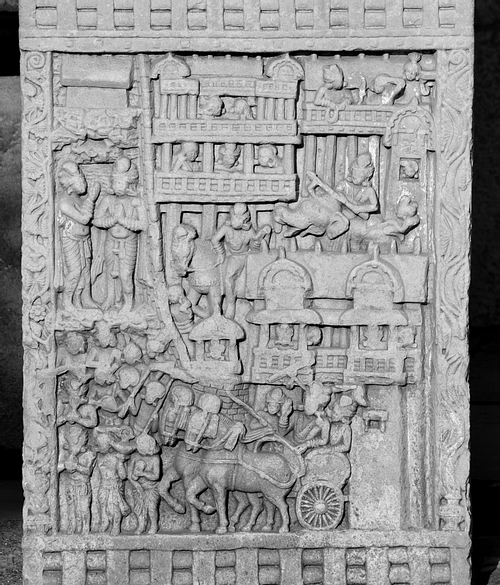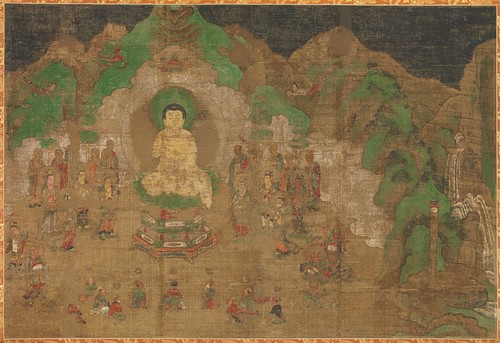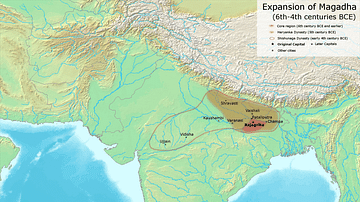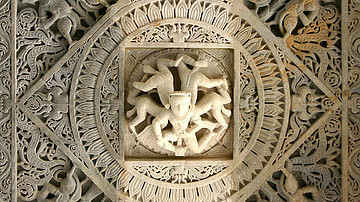
Bimbisara (c. 545/544 BCE - c. 493/492 BCE) was a king of the Magadha Kingdom who is credited with establishing imperial dominance in the Indian subcontinent. Son of a minor king called Bhattiya, he belonged to the Haryanka Dynasty, which is said to be the second imperial dynasty of Magadha. However, it is only from Bimbisara's reign that the historicity of different Indian kings can be verified with any certainty. Before the Haryanka Dynasty, the accounts of various Indian kings are mythical and cannot be verified with any archaeological evidence.
Bimbisara ruled at a time when Gautama Buddha (c. 563 BCE - c. 483 BCE) and Mahavira Vardhamana (c. 599 BCE - c. 527 BCE as per the Jaina tradition), the respective founders of Buddhism and Jainism, both started their teachings. Bimbisara has been given much importance in the early Buddhist and Jaina sources because he probably endorsed both these religions equally. He ruled from a place called Girivraja which was also known as Rajagriha and is identified with modern Rajgir in the state of Bihar today. It is said that the city of Rajagriha was built by Bimbisara himself. The city was covered on all sides by five hills creating a natural fortification, and later on Bimbisara's son, Ajatashatru covered the gaps with stone walls.
Early Life & Rise to Power
Around the time of Bimbisara, the Indian subcontinent was forming into two major political units, the Mahajanapadas and the Janapadas. There were 16 Mahajanapadas (the name roughly means great footholds of people); these were the greater kingdoms. Some were republics ruled by a committee, while others were monarchies ruled by a dynasty. During the initial years of the Haryanka Dynasty, the Indian civilization was being refocused from the northwest to the eastern and central zones of India with four great kingdoms on the rise there – Kosala, Avanti, Vatsa, and finally Magadha. Ancient Kosala corresponds to the modern-day Uttar Pradesh state of India, Avanti was roughly present-day central India, mostly the state of Madhya Pradesh, Vatsa was also some part of present-day Uttar Pradesh state, while the ancient Magadha Empire roughly corresponds to the present-day state of Bihar, Jharkhand, some parts of West Bengal, Odisha, Uttar Pradesh, and the countries of Nepal and Bangladesh.
Bimbisara was born c. 559/558 BCE and was also known as Shrenika. During his childhood, Bimbisara saw his father carrying a futile military campaign against the Anga King Brahmadatta. So when he came to power at a very early age of 15, the first thing he sought was revenge on Brahmadatta. He was also motivated by the commercial potential of annexing Anga which was strategically located near the Bay of Bengal. Hence his first campaign was attacking that kingdom. Being an able general and trained for ancient Indian warfare right from his childhood, he could defeat the Anga forces easily. Bimbisara then made his son Ajatashatru the governor of Anga. This way he gained access to the oceanic routes of Anga which brought flourishing overseas trade to his kingdom and he also provided his natural heir with some valuable insights into the workings of commerce and administration by placing him in command there.
Conquests & Marriage Alliances
After placing his warrior son Ajatashatru there and thereby securing complete hold over Anga (roughly modern-day Bengal and Bangladesh with some parts of Odisha), Bimbisara shifted his focus to the other powerful kingdoms of the subcontinent. He was a very able military general but, aware of the limitations of his forces against the greater kingdoms of his time, he also sought marriage alliances with kingdoms which he could not subdue in order to increase his sphere of influence. Soon, he secured the alliance of the powerful Kosala kingdom by marrying their king Prasanajita's sister and thereby also gaining the holy city of Kashi as a dowry. Being one of the holiest places in Hinduism and consequently a good source of income, Kashi further strengthened the coffers of Magadha.

Next, Bimbisara married a Licchavi princess, Chellana, daughter of one of their kings Chetaka from the powerful confederation of the Vrijjis. She was the mother of his son Ajatashatru, Bimbisara's successor. Bimbisara also married a princess from the Madri clan of middle Punjab. With his position strengthened, Bimbisara set his eyes on the most powerful kingdom of that time – Avanti, with its capital at Ujjain. But even after several battles, neither Bimbisara nor King Pradyota of Avanti emerged victorious. This deadlock would also continue during Ajatashatru's reign. However, being the sound strategist he was, Bimbisara soon formed a friendship with King Pradyota. Buddhist sources also state that when King Pradyota once fell ill, it was Bimbisara who sent him a specialised apothecary and got him treated to recovery.
Bimbisara's Administration
Though Bimbisara's conquests and military exploits were limited, his greatest achievement was the system of government and administration established during his rule, which would be followed by many of the subsequent dynasties of Magadha. Bimbisara established a chain of command of officials which ensured proper taxation and collections. He was said to have been in possession of around 80,000 villages which had a village headman in charge of each. Those headmen were entrusted with the collection of taxes as well as with the responsibility of running the administration. Bimbisara also appointed high ranking officials for judicial, military, and financial administration. Any official found lazy and a non-performer was replaced, but otherwise, he also listened to the sound advice of his closest high-ranking ministers.

Magadha's prosperity during Bimbisara was not only affected by his foresight and intelligent administration, it was assisted by other factors too. Magadha was traditionally rich in minerals and iron ores, and the region was full of wooded forests. That provided armaments, elephants and ample wood for the army, and the fertile Gangetic plains always provided a surplus to the farmers. Bimbisara maintained the Indian tradition of having four divisions in his army – infantry, cavalry, chariots and elephants. After annexing Anga, he also probably formed some units of navy there. All these were inherited by Ajatashatru who would strengthen it by further conquests and armaments.
Religion
Magadha, unlike the north and northwest of India, at that time was outside the ambit of the Vedic Corpus and was sometimes looked down upon by the high-caste Hindu Brahmins. Not only that, since Magadha endorsed many other religions other than Hinduism (like Buddhism, Jainism, Ajivikaism, etc.), they were disdainfully insulted in many circles and in contemporary literature by the Brahmins. The Buddhist chronicles mention Bimbisara as a follower of Buddha, while the Jaina sources make a similar claim. What we know is that Buddha probably visited Girivraja during his rule, where he received much assistance from Bimbisara who hosted him and his disciples.

Bimbisara was said to have supported the monks of all religions who came to visit him. He also supported religion by making many services free in his kingdom for the ascetics and monks. He is also said to have constructed many hermitages for them and, especially, made the ferry services free to them. Since Magadha was the centre of the Indo-Gangetic Plains, the river transport was one of the most important aspects of the kingdom then. There are also various legends associated with Bimbisara and his association with Gautama Buddha. Even some of his wives were apparently Buddhist followers, and according to Buddhist chronicles, Bimbisara's son Ajatashatru also became a follower of Gautama Buddha later in his life. There is a legend that Ajatashatru sought the counsel of Buddha to help him in his long battle with the Licchavis.
Death & Legacy
Bimbisara for all his astuteness had the follies of an early Indian king too. He always believed in his son blindly and never checked on him. Ajatashatru was ambitious right from a very young age, and he was egged on to commit patricide by other factors too. According to Buddhist sources, Ajatashatru was continuously ill-advised by Gautama Buddha's wicked cousin Devadatta. Devadatta wanted a position for himself in the kingdom and he saw Buddha's growing influence on Bimbisara as a detriment to that ambition. So he tricked and convinced Ajatashatru to usurp the throne by deposing and executing his own father, which Ajatashatru did. However, there is also a legend which says Bimbisara took his own life after being imprisoned. Whatever the case, Bimbisara's queen from the Kosala kingdom also died in a short while either in grief or by committing suicide. Ajatashatru soon realised his mistake and upon that, he supposedly met Gautama Buddha. This event is depicted in a sculpture recovered from Bharhut in India, which now adorns the gallery of the Indian Museum in the city of Kolkata.
Bimbisara, in a way, unified the Magadha Empire. He sowed the seeds which later saw others taking Magadha into greater heights, and uniting an entire subcontinent. He started a policy of religious tolerance by enabling any religion which came to his kingdom to flourish and also encouraged arts and crafts in his kingdom. He has been very highly spoken of in the Buddhist and the Jaina sources he is known to have made a positive cultural impact on his citizens. He established a solid foundation of administration and trade in his kingdom and has been remembered in Indian history not only as an able ruler who founded the supremacy of the Magadha Kingdom but also the first major ruler of India whose existence can be established with any certainty. He was succeeded by Ajatashatru (r. c. 494/493 BCE - c. 462 BCE) who was then succeeded by his son Udaya again after committing patricide.






